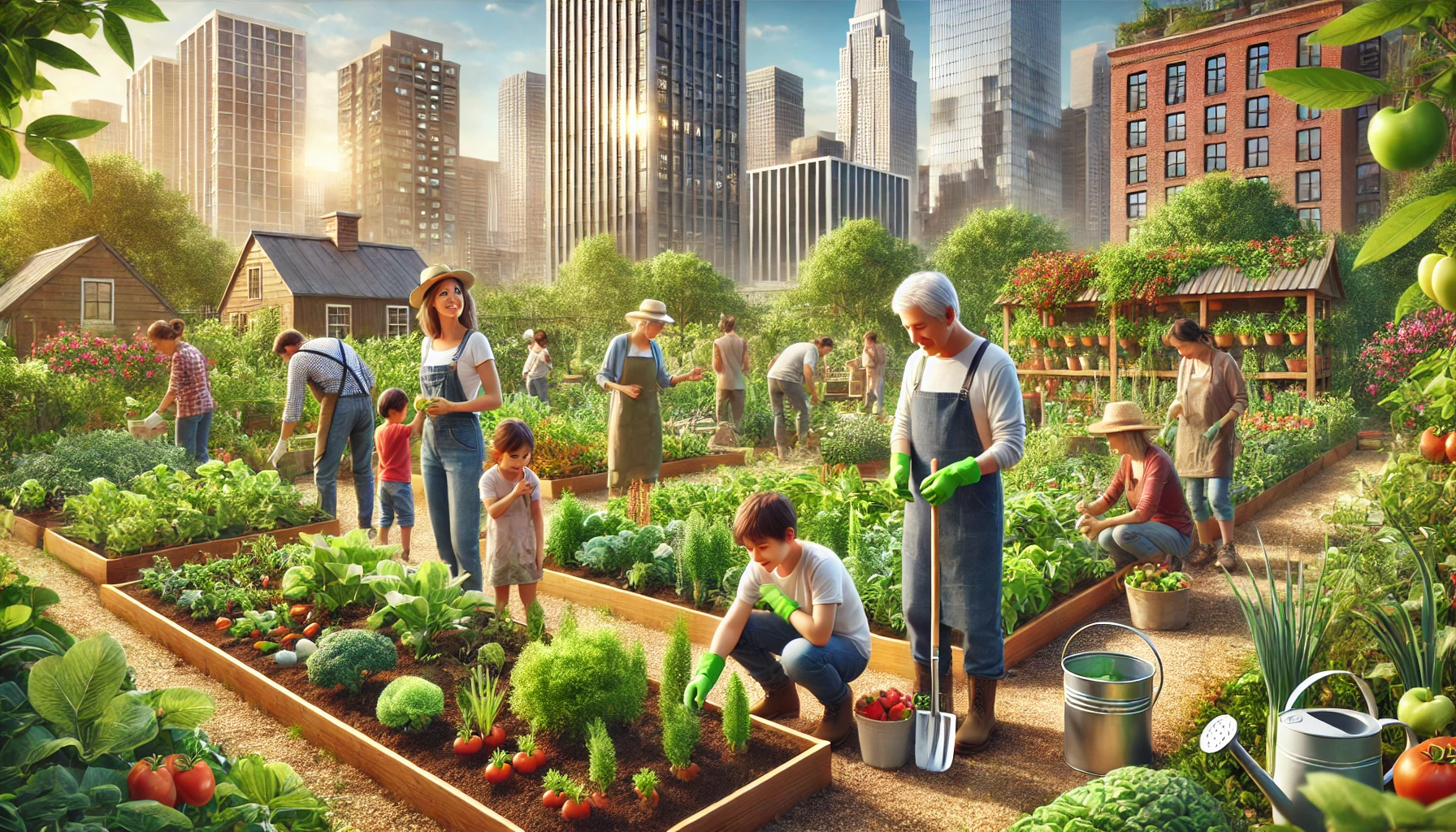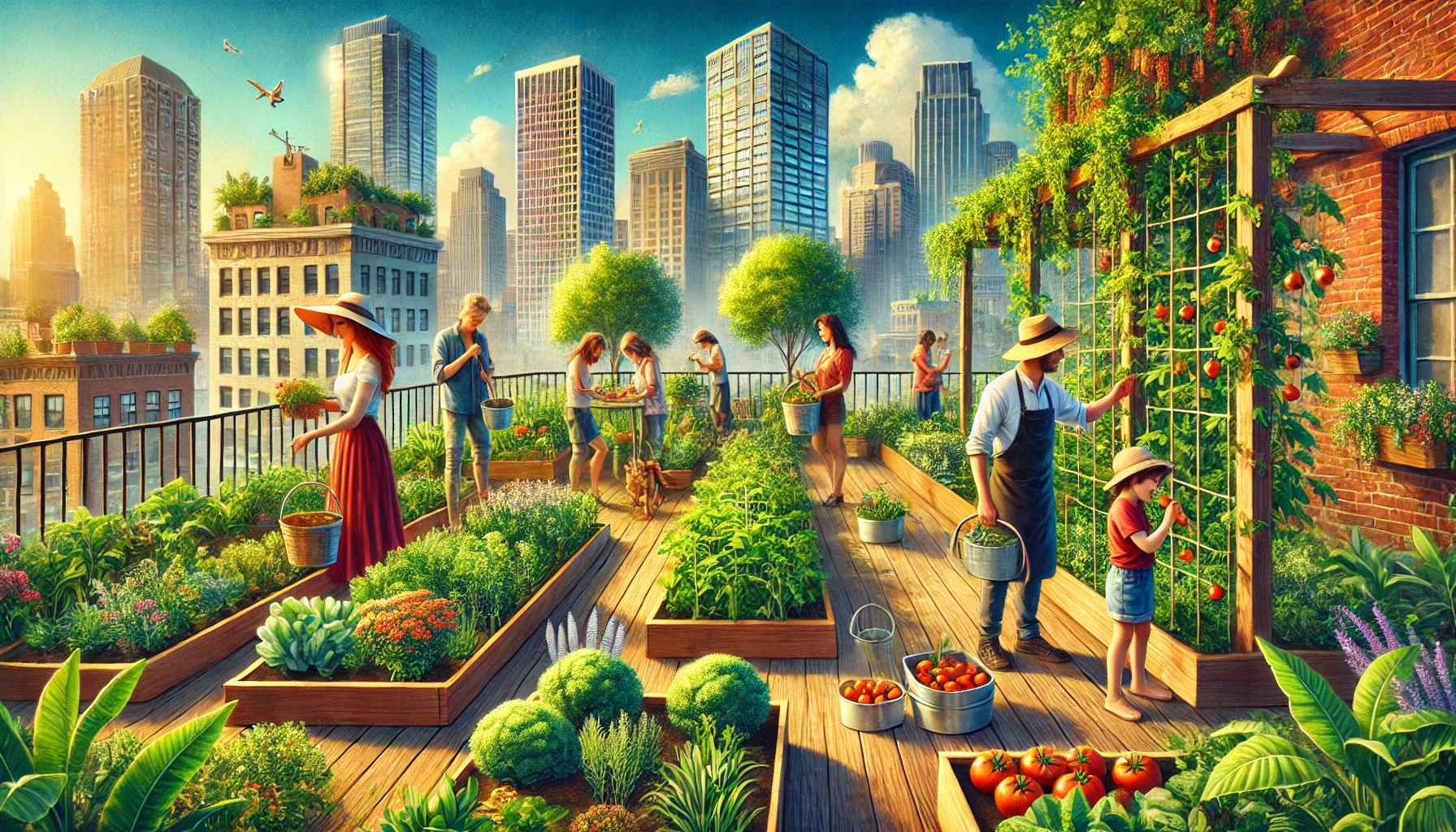Urban Organic Gardening Tips are your best bet when you’re aiming to grow fresh, healthy produce in a bustling city. City life often tempts us with conveniences, but there’s something truly rewarding about getting your hands dirty and seeing your hard work blossom, quite literally.
At its core, urban organic gardening is just like traditional gardening but tailor-made for the challenges of city living. It’s all about bringing nature to your apartment balcony, rooftop, or community plot, using methods that respect the environment and keep your harvest free of pesticides and harmful chemicals.
The beauty of organic gardening lies in its simplicity and sustainability. Not only does it contribute positively to the environment, but it also ensures you’re consuming higher-quality produce. Imagine the joy of picking fresh herbs for dinner right from your living room.
With the gridded chaos of the city all around, creating an organic garden might feel a bit daunting, but fear not. It’s not only possible; it’s more rewarding than you’d imagine. Efficiently utilizing limited space in an urban setting can lead to surprising yields and a healthier lifestyle.
Understanding the Gardening 3-Year Rule
The gardening 3-year rule might sound like one of those countryside secrets, but it’s just as handy for city folks. Think of it as crop rotation on a mini-scale, perfect for keeping your small patch in top-notch condition.
The big idea is pretty simple: don’t grow the same thing in the same soil for three years straight. This smart move helps by reducing pests that love to hunker down and wait for their favorite snack (like your tomatoes) to pop up again.
Plus, it keeps the soil’s nutrients balanced. Different plants need different stuff, so swapping them around means you’re not draining all the goodies from the soil. For urban gardeners, this swap can happen even within a few pots.
Even with limited space, rotating your herbs and veggies in small containers can keep your plants vibrant and productive. It’s like giving your garden a well-deserved vacation.
Adapting this to a city setting means thinking creatively, maybe with an indoor herb garden one season and a couple of buckets of leafy greens the next. Whatever works, just keep your plants on their toes—figuratively speaking, of course.
So, while big fields might have acres to think about, even your windowsill can make the most of the 3-year rule. Just a little planning and your urban garden’s ready to roll with the changes.
Best Practices for Urban Gardening
Choosing the right plants can kickstart your urban gardening. Think small-footprint heroes like herbs, salad greens, and compact vegetables—perfect for tight spaces. These are often low-maintenance and can be incredibly rewarding.
You’ll want soil that’s rich and ready to nurture your plants. Bagged organic potting mix should do the trick for most urban setups. If you’re feeling adventurous, your own compost blend can be a win-win, helping you recycle kitchen scraps while enriching your soil.
Container gardening is your best friend in a concrete jungle. From trendy hanging baskets to simple pots on your balcony, these allow you to move your plants around to catch the best light and moisture.
Vertical gardens are a brilliant use of space—think of stacking dizzying levels of floral beauty or an edible wall of greens. They transform boring walls and save precious floor space.
Water conservation’s important, especially when you’re growing in a city. Drip irrigation systems or simple watering cans can be effective. Collecting rainwater could also be an option if you’re lucky enough to have a collection setup in place.
Mixing in native plants can greatly benefit your patch. They’ll likely adapt better to the local climate and won’t demand your constant attention. Perfect for someone juggling multiple city commitments.
Challenges of Urban Gardening
City living often means tight spaces and pollution, which can make gardening seem like a far-off dream. Think about the lack of backyards or the shade from towering buildings that block sunlight.
These constraints demand creativity. Try mini greenhouses or raised beds that can fit almost anywhere. Clever use of mirrors or reflective surfaces can boost light to give your plants that sunny vibe even in dim corners.
Urban gardeners might face pollution issues, with air contaminants potentially affecting plant health. Prepping your soil and washing your produce thoroughly is a good practice.
Resources can sometimes feel like they’re hiding—finding quality compost or organic fertilizers might require some searching. Local gardening clubs or online communities can be a real lifesaver, connecting you to others dealing with the same urban challenges.
Securing gardening spots in shared spaces or community gardens might involve navigating some administration hurdles. Be patient—it’s worth it for the fresh produce and connection to other green-thumbed folks.
Once you get the hang of it, the skyscrapers and city lights become a memorable backdrop for your urban oasis. Embrace the hustle while you nurture your slice of nature.
Assessing Miracle-Gro for Organic Gardening
Miracle-Gro is one of those big names tossed around in gardening circles, but is it a buddy for organic growers? Let’s think about how it fits into the organic world.
The crux of organic gardening revolves around keeping it natural—no synthetic fertilizers or pesticides along for the ride. Miracle-Gro products, especially those that aren’t organic-specific, sometimes lean heavy on synthetic components.
If you’re sticking to organic principles, it’s crucial to check the label or find alternative products with organic certification. Look for OMRI-listed products that are verified for safe use in organic gardening.
Curious about alternatives? Compost teas, fish emulsions, or even homemade blends can provide your plants the nourishment they need while keeping things all-natural.
The key is balancing what works for your garden while staying true to the essence of organic gardening. It’s about sustainability and nurturing the ecosystem you’re building, no matter how small your urban plot might be.
So, Miracle-Gro might not be the ideal choice if organic purity’s your game plan, but with a little digging, you can find plenty of other options that keep your greens healthy and organic-certified.
Experience and Expertise in Urban Gardening
Success stories from urban gardening enthusiasts all over prove that it’s more than possible to thrive amidst city life. Whether you’re scaling a sprawling rooftop garden or tending to dainty pots on the windowsill, each story adds a sprinkle of inspiration.
Embrace the little victories—like finally growing that stubborn basil or seeing your first tomato ripen. Sharing tips and learning from the experiences of others can cut down your trial and error time significantly.
Urban gardening experts often suggest starting small. Get comfortable with a few manageable plants and gradually experiment. That way, you’re savoring every leaf and fruit, instead of getting overwhelmed.
Technology plays a surprising role in modern urban gardening. Apps can help you track water schedules, identify plant diseases, or connect with a community of fellow gardeners. Imagine having a gardening coach right in your pocket!
Don’t underestimate the power of workshops and local meet-ups, which can often provide hands-on guidance and a stronger sense of connectedness. These can transform learning into a community-driven adventure.
Finally, remember that part of becoming an expert is embracing failures. Each mistake is a stepping stone—not just to better gardening but to understanding the rhythm of nature in your urban jungle.

Conclusion: Cultivating a Green Future in Urban Spaces
Urban gardening offers more than just fresh produce; it brings a slice of nature into our urban lives and can transform the concrete jungles into green sanctuaries.
Every seed sown is a step towards a sustainable future and a healthier lifestyle for you and the planet.
By understanding the principles mentioned in each section, you’ve equipped yourself with the tools to tackle urban gardening with confidence.
Whether it’s adopting the 3-year rule, finding the right soil, or experimenting with organic fertilizers, those small changes add up to significant impacts over time.
The beauty of urban gardening is in its adaptability. There’s no one-size-fits-all approach, and that’s the fun of it—experiment and find what suits you best.
Encourage others around you to pick up a trowel and get planting. Urban gardening is more than a hobby; it’s a movement towards a greener, more connected community.
So, go ahead, let your urban garden bloom and share the joy of nurturing life right in the heart of the city.


Loved this article! It’s so cool to think that even a tiny apartment balcony can become a mini organic farm. The 3-year rule makes total sense, but I’m curious—how would you rotate crops if you’re only working with a few small pots? Also, with city pollution being a thing, are there certain plants that can handle poor air quality better (or maybe even help clean it up)? Excited to hear more tips on making urban gardening work in real life!
Thanks for your kind words! For small spaces, crop rotation can be as simple as switching plant families between pots each season—leafy greens, then fruiting plants, then root crops. As for air pollution, hardy plants like spider plants, snake plants, and pothos help clean the air, while herbs like rosemary and thyme are more resistant to urban conditions. Stay tuned for more urban gardening tips!